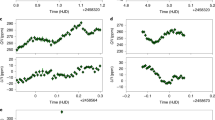Abstract
We explore the detailed polarization behaviour of pulsar 0823 + 26 using the technique of constructing partial ‘mode-separated’ profiles corresponding to the primary and secondary polarization modes. The characteristics of the two polarization modes in this pulsar are particularly interesting, both because they are anything but orthogonal and because the secondary mode exhibits a structure seen neither in the primary mode nor in the total profile. The new leading and trailing features in the secondary mode, which appear to represent a conal component pair, are interpreted geometrically on the basis of their width and the associated polarization-angle traverse as an outer cone.
If the secondary-mode features are, indeed, an outer cone, then questions about the significance of the pulsar’s postcursor component become more pressing. It seems that 0823 + 26 has a very nearly equatorial geometry, in that both magnetic poles and the sightline all fall close to the rotational equator of the star. We thus associate the postcursor component with emission along those bundles of field lines which are also equatorial and which continue to have a tangent in the direction of our sight line for a significant portion of the star’s rotation cycle. It seems that in all pulsars with postcursor components, this emission follows the core component, and all may thus have equatorial emission geometries. No pulsars with precursors in this sense — including the Crab pulsar — are known.
The distribution of power between the primary and secondary modes is very similar at both 430 and 1400 MHz. Our analysis shows that in this pulsar considerable depolarization must be occurring on time scales that are short compared to the time resolution of our observations, which is here some 0.5–1.0 milliseconds. One of the most interesting features of the modeseparated partial profiles is a phase offset between the primary and secondary modes. The secondary-mode ‘main pulse’ arrives some 1.5 ± 0.1‡ before the primary-mode one at 430 MHz and some 1.3 +0.1 ‡ at 21 cm. Given that the polar cap has an angular diameter of 3.36‡, we consider whether this is a geometric effect or an effect of differential propagation of the two modes in the inner magnetosphere of the pulsar.
Similar content being viewed by others
References
Backer, D. C., Boriakoff, V., Manchester, R. N. 1973,Nat. Phys. Sci.,243, 77.
Backer, D. C. 1973,Astrophys. J.,182, 245.
Backer, D. C., Rankin, J. M. 1980,Astrophys. J. Suppl,42, 143.
Barnard, J. J., Arons, J. 1986,Astrophys. J.,302, 138.
Bartel, N., Sieber, W., Wielebinski, R. 1978,A & A.,68, 361.
Blaskiewicz, M., Cordes, J. M., Wasserman, I. 1991,Astrophys. J.,370, 643.
Cordes, J. M., Rankin, J. M., Backer, D. C. 1978,Astrophys. J.,223, 961.
Craft, H. D., Lovelace, R. V. E., Sutton, J. M. 1968,I.A.U. Circ. No. 2100.
Daugherty, J. K., Harding, A. K. 1986,Astrophys. J.,309, 362.
Gil, J. A., Snakowski, J. K., Stinebring, D. R. 1991,Astrophys. J.,242, 119.
Gil, J. A., Lyne, A. G., Rankin, J. M., Snakowski, J. K., Stinebring, D. R. 1992,A&A,255, 181.
Gil, J. A., Kijak, J. 1993,A&A,273, 563.
Gil, J. A., Kijak, J., Seiradakis, J. H. 1993,A&A,272, 268.
Hagan, J. 1987,NAIC Electronics Department Manual No. 8319.
Hankins, T. H., Fowler, L. A. 1986,Astrophys. J.,304, 256.
Hankins, T. H., Rickett, B. J. 1986,Astrophys. J.,311, 684.
Hankins, T. H., Rankin, J. M. 1994, private communication.
Izvekova, V.A., Kuz’min, A. D., Malofeev, V.M., Shitov, Yu. P. 1981,Astrophys. Space Sci.,78, 45.
Komesaroff, M. M. 1970,Nature,225, 612.
Kramer, M., Wielebinski, R., Gil, J. A., Seiradakis, J. H., Jessner, A. 1994,A&A,107, 527.
Lang, K. R. 1969,Astrophys. J. Lett.,158, L175.
Lyne, A. G., Manchester, R. N. 1988,Mon. Not. R. astr. Soc.,234, 477.
Manchester, R. N., Hamilton, P. A., McCulloch, P. M. 1980,Mon. Not. R. astr. Soc.,192, 153.
McCulloch, P.M., Hamilton, P. A., Manchester, R.N., Abies, J.G.1978,Mon. Not. R. astr. Soc.,183, 645.
McCulloch, P. M., Hamilton, P. A., Manchester, R. N. 1982, private communication.
Narayan, R., Vivekanand, M. 1982,A&A,113, L3.
Perillat, P. 1988,NAIC Computer Department Report # 23.
Perillat, P. 1992, private communication.
Perry, T. E., Lyne, A. G. 1985,Mon. Not. R. astr. Soc.,212, 489.
Phillips, I A., Wolszczan, A. 1992,Astrophys. J.,385, 273.
Popov, M. V., Sieber, W. 1990,Sov. Astr.,34, 382.
Radhakrishnan, V., Cooke, D. J. 1969,Astrophys. J. Lett.,3, 225.
Rankin, J. M. 1983b,Astrophys. J.,274, 359. (Paper II)
Rankin, J. M. 1986,Astrophys. J.,301, 901. (Paper III)
Rankin, J. M. 1988,Astrophys. J.,325, 314.
Rankin, J. M. 1990,Astrophys. J.,352, 247. (Paper IV)
Rankin, J. M. 1993a,Astrophys. J.,405, 285. (Paper VIa)
Rankin, J. M. 1993b,Astrophys. J. (Suppl.),85, 145. (Paper VIb)
Rankin, J. M., Benson, J. M. 1981,Astr. J.,86, 418.
Rankin, J. M., Campbell, D. B., Backer, D. C. 1974,Astrophys. J.,188, 609.
Rankin, J. M., Campbell, D. B., Spangler, S. 1975,NAIC Report # 46.
Rankin, J. M., Rathnasree, N. 1996, in preparation.
Rankin, J. M., Stinebring, D. R., Weisberg, J. M. 1989,Astrophys. J.,346, 869.
Rankin, J. M., Wolszczan, A., Stinebring, D. R. 1988,Astrophys. J.,324, 1048.
Ritchings, R. T. 1976,Mon. Not. R. astr. Soc.,176, 249.
Sieber, W. 1973,A&A,28, 237.
Stinebring, D. R., Cordes, J. M., Rankin, J. M., Weisberg, J. M., Boriakoff, V. 1984,Astrophys. J. (Suppl),55, 247.
Suleymanova, S. A., Shitov, Yu. P. 1994,Astrophys. J. Lett.,422, L17.
Taylor, J. H., Huguenin, G. R. 1969, Symposium on Pulsars and High Energy Activity in Supernova Remnants, Academia Nationale dei Lincei, Rome, 1969 December 18.
Xilouris, K. M., Seiradakis, J. M., Gil, J., Sieber, W., Wielebinski, R. 1995A&A,293, 153.
Author information
Authors and Affiliations
Rights and permissions
About this article
Cite this article
Rankin, J.M., Rathnasree, N. Polarization-mode separation and the emission geometry of pulsar 0823 + 26: A new pattern of pulsar emission?. J Astrophys Astron 16, 327–355 (1995). https://doi.org/10.1007/BF02715608
Received:
Accepted:
Issue Date:
DOI: https://doi.org/10.1007/BF02715608




